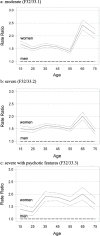Pattern of inpatient care for depression: an analysis of 232,289 admissions
- PMID: 32677945
- PMCID: PMC7364660
- DOI: 10.1186/s12888-020-02781-z
Pattern of inpatient care for depression: an analysis of 232,289 admissions
Abstract
Background: The prevalence of major depressive disorder (MDD) in women is up to 50% higher as compared to men. However, little is known about discrepancies in health care utilization between depressed female and male patients. Consequently, the aim of the present study was to elucidate gender differences regarding the frequency of hospital admissions and the length of inpatient treatment for MDD across the lifespan.
Methods: This nationwide, registry-based study analyzed all inpatient admissions in psychiatric hospitals due to recurrent/non-recurrent MDD episodes according to ICD-10 (moderate (F32/33.1), severe (F32/33.2), severe with psychotic features (F32/33.3)) in Austria across 14 years. We calculated weekly admission rates per 100,000 patients by directly age-standardized rates.
Results: Across 232,289 admissions (63.2% female) the population based admission rates in MDD were significantly higher in women (p < 0.001). Female to male ratios across subgroups were 1.65 (F32/33.1), 1.58 (F32/33.2), 1.73 (F32/33.3), and peaked around 65 years (ratio ≥ 2 for all subgroups). Length of hospital stay for women was significantly longer in all depression subtypes (p < 0.001).
Conclusions: Elevated rates of inpatient treatment in women cannot solely be explained by a higher MDD prevalence and are dependent on age and type of depressive episode. Irrespective of the type and severity of the mood episode, women exhibit longer hospitalisation times.
Keywords: Age; Depression; Gender; Hospitalization; Length of stay; Sex.
Conflict of interest statement
BV is a member of the editorial board of the journal. All authors declare that no competing financial interests exist.
Figures

Similar articles
-
Seasonality in Major Depressive Disorder: Effect of Sex and Age.J Affect Disord. 2022 Jan 1;296:111-116. doi: 10.1016/j.jad.2021.09.051. Epub 2021 Sep 22. J Affect Disord. 2022. PMID: 34600171
-
Influence of gender on inpatient treatment for bipolar disorder: An analysis of 60,607 hospitalisations.J Affect Disord. 2018 Jan 1;225:104-107. doi: 10.1016/j.jad.2017.08.007. Epub 2017 Aug 10. J Affect Disord. 2018. PMID: 28810176
-
Inpatient treatment of major depression in Austria between 1989 and 2009: impact of downsizing of psychiatric hospitals on admissions, suicide rates and outpatient psychiatric services.J Affect Disord. 2011 Sep;133(1-2):93-6. doi: 10.1016/j.jad.2011.03.031. Epub 2011 Apr 16. J Affect Disord. 2011. PMID: 21497914
-
Affective disorders in older inpatients.Int J Geriatr Psychiatry. 2004 May;19(5):487-92. doi: 10.1002/gps.943. Int J Geriatr Psychiatry. 2004. PMID: 15156551
-
Systematic reviews of the effectiveness of day care for people with severe mental disorders: (1) acute day hospital versus admission; (2) vocational rehabilitation; (3) day hospital versus outpatient care.Health Technol Assess. 2001;5(21):1-75. doi: 10.3310/hta5210. Health Technol Assess. 2001. PMID: 11532238 Review.
Cited by
-
Factors related to the length of stay for major depressive disorder patients in China: A real-world retrospective study.Front Public Health. 2022 Jul 29;10:892133. doi: 10.3389/fpubh.2022.892133. eCollection 2022. Front Public Health. 2022. PMID: 35968457 Free PMC article.
-
Hospital Length of Stay and Associated Factors in Adult Patients with Depression in Germany: A Cross-Sectional Study.J Clin Med. 2024 Jul 25;13(15):4331. doi: 10.3390/jcm13154331. J Clin Med. 2024. PMID: 39124598 Free PMC article.
-
Patient characteristics, validity of clinical diagnoses and Outcomes Associated with Suicidality in Inpatients with Symptoms of Depression (OASIS-D): design, procedures and outcomes.BMC Psychiatry. 2023 Oct 13;23(1):744. doi: 10.1186/s12888-023-05230-9. BMC Psychiatry. 2023. PMID: 37828493 Free PMC article.
-
Association between the domestic use of solid cooking fuel and increased prevalence of depression and cognitive impairment in a big developing country: A large-scale population-based study.Front Public Health. 2022 Nov 24;10:1038573. doi: 10.3389/fpubh.2022.1038573. eCollection 2022. Front Public Health. 2022. PMID: 36504928 Free PMC article.
References
-
- Bauer M, Severus E, Möller HJ, et al. Pharmacological treatment of unipolar depressive disorders: summary of WFSBP guidelines. Int J Psychiatry Clin Pract. 2017;21(3):166–76. - PubMed
-
- Vos T, Barber RM, Bell B, et al. Global, regional, and national incidence, prevalence, and years lived with disability for 301 acute and chronic diseases and injuries in 188 countries, 1990-2013: a systematic analysis for the global burden of disease study 2013. Lancet. 2015;386(9995):743–800. - PMC - PubMed
-
- Alonso J, Angermeyer MC, Bernert S, Bruffaerts R, Brugha TS, Bryson H, de Girolamo G, Graaf R, Demyttenaere K, Gasquet I, et al. Prevalence of mental disorders in Europe: results from the European study of the epidemiology of mental disorders (ESEMeD) project. Acta Psychiatr Scand Suppl. 2004;420:21–27. - PubMed
-
- Kuehner C. Gender differences in unipolar depression: an update of epidemiological findings and possible explanations. Acta Psychiatr Scand. 2003;108(3):163–174. - PubMed
MeSH terms
LinkOut - more resources
Full Text Sources

